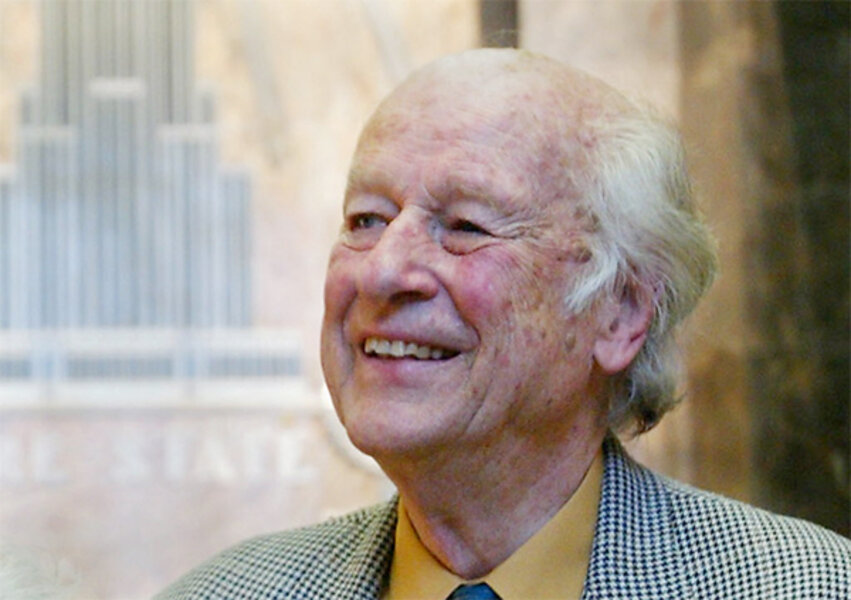Ray Harryhausen was a special-effects pioneer
Loading...
When Ray Harryhausen was 13, he was so overwhelmed by "King Kong" that he vowed he would create otherworldly creatures on film. He fulfilled his desire as an adult, thrilling audiences with skeletons in a sword fight, a gigantic octopus destroying the Golden Gate Bridge, and a six-armed dancing goddess.
On Tuesday, Harryhausen died at London's Hammersmith Hospital. He was 92.
Biographer and longtime friend Tony Dalton confirmed the special-effects titan's death, saying it was too soon to tell the exact cause. He described Harryhausen's passing as "very gentle and very quiet."
"Ray did so much and influenced so many people," Dalton said. He recalled his friend's "wonderfully funny, brilliant sense of humor" and love of Laurel and Hardy, adding that, "His creatures were extraordinary, and his imagination was boundless."
Though little known by the general public, Harryhausen made 17 movies that are cherished by devotees of film fantasy.
George Lucas, who borrowed some of Harryhausen's techniques for his "Star Wars" films, commented: "I had seen some other fantasy films before, but none of them had the kind of awe that Ray Harryhausen's movies had."
The late science fiction author Ray Bradbury, a longtime friend and admirer, once remarked: "Harryhausen stands alone as a technician, as an artist and as a dreamer. ... He breathed life into mythological creatures he constructed with his own hands."
Harryhausen's method was as old as the motion picture itself: stop motion. He sculpted characters from 7.5 cm to 38 cm (3 inches to 15 inches) tall and photographed them one frame at a time in continuous poses, thus creating the illusion of motion. In today's movies, such effects are achieved digitally.
Harryhausen admired the three-dimensional quality of modern digital effects, but he still preferred the old-fashioned way of creating fantasy.
"I don't think you want to make it quite real. Stop motion, to me, gives that added value of a dream world," he said.
Ray Frederick Harryhausen was born in Los Angeles on June 19, 1920. As a boy, he saw the 1925 silent fantasy "The Lost World," Willis O'Brien's stop-motion movie about dinosaurs in a South American jungle.
"I always remember the dinosaur falling off the cliff," he remarked at a Vancouver, Canada, animation and effects convention in 2001. "That stuck in my mind for years."
His future was assured in 1933 when he saw "King Kong" at Grauman's Chinese theater in Hollywood.
"I used to make little clay models," he recalled. "When I saw 'King Kong,' I saw a way to make those models move."
He borrowed a 16 mm camera, cut up his mother's old fur coat to make a bear model, and made a film about himself and his dog being menaced by a bear. His parents were so impressed that he was spared a spanking for ruining the fur coat.
During World War II, Harryhausen joined Frank Capra's film unit, which made the "Why We Fight" propaganda series. After the war, he made stop-motion versions of fairy tales that prompted his idol, O'Brien, to hire him to help create the ape in "Mighty Joe Young," an achievement that won an Academy Award. Harryhausen then embarked on a solo career.
In contrast to the millions spent on digital effects today, Harryhausen made his magic on a shoestring. His first effort, "The Beast from 20,000 Fathoms" (1953), cost $250,000 for the entire film. He commented wryly in 1998: "I find it rather amusing to sit through the on-screen credits today, seeing the names of 200 people doing what I once did by myself."
He found ways to economize. For "It Came from Beneath the Sea" (1955) he employed an octopus with six tentacles instead of eight. That saved time.
"Jason and the Argonauts" (1963) demonstrated the intricacy of Harryhausen's tricks. He had three live actors dueling seven skeletons. It took four months to produce a few minutes on the screen.
Other notable achievements included the film "Earth vs. the Flying Saucers," where aliens slice through the Washington Monument and crash into the U.S. Capitol. He also was behind "The Golden Voyage of Sinbad," where a one-eyed centaur battles a part-lion, part-eagle creature known as a griffin.
Harryhausen's film "The Clash of the Titans" (1981), did have a big budget and major cast: Laurence Olivier, Maggie Smith, Burgess Meredith, Harry Hamlin and Claire Bloom. Hamlin as Perseus struggled to tame a white-winged Pegasus and to battle the snake-haired Medusa.
After the film, Harryhausen retired, explaining, "I was tired of spending year after year in a dark room."
He and his wife, Diana, lived in London, where he fashioned bronze replicas of his movie creations. He often appeared at fantasy conventions and in 1992 received a special award from the Motion Picture Academy.
Darren G. Davis, the publisher of Bluewater Productions, called Harryhausen's death the passing of an icon.
"From the first time I saw 'Jason and the Argonauts' and 'Clash of the Titans,' I was spellbound," he said of the man whose imprint is found on Bluewater's "Ray Harryhausen Presents" comic anthology. "I feel so blessed for the opportunity to have worked with him through the years on numerous comic adaptations, graphic novel sequels and other projects based on his visionary work."
Bradbury, who had met Harryhausen in 1938 and wrote the story for "The Beast from 20,000 Fathoms," one said of the film master: "He and I made a pact to grow old but never grow up — to keep the pterodactyl and the tyrannosaurus forever in our hearts."
Harryhausen is survived by his wife and daughter, Vanessa.







